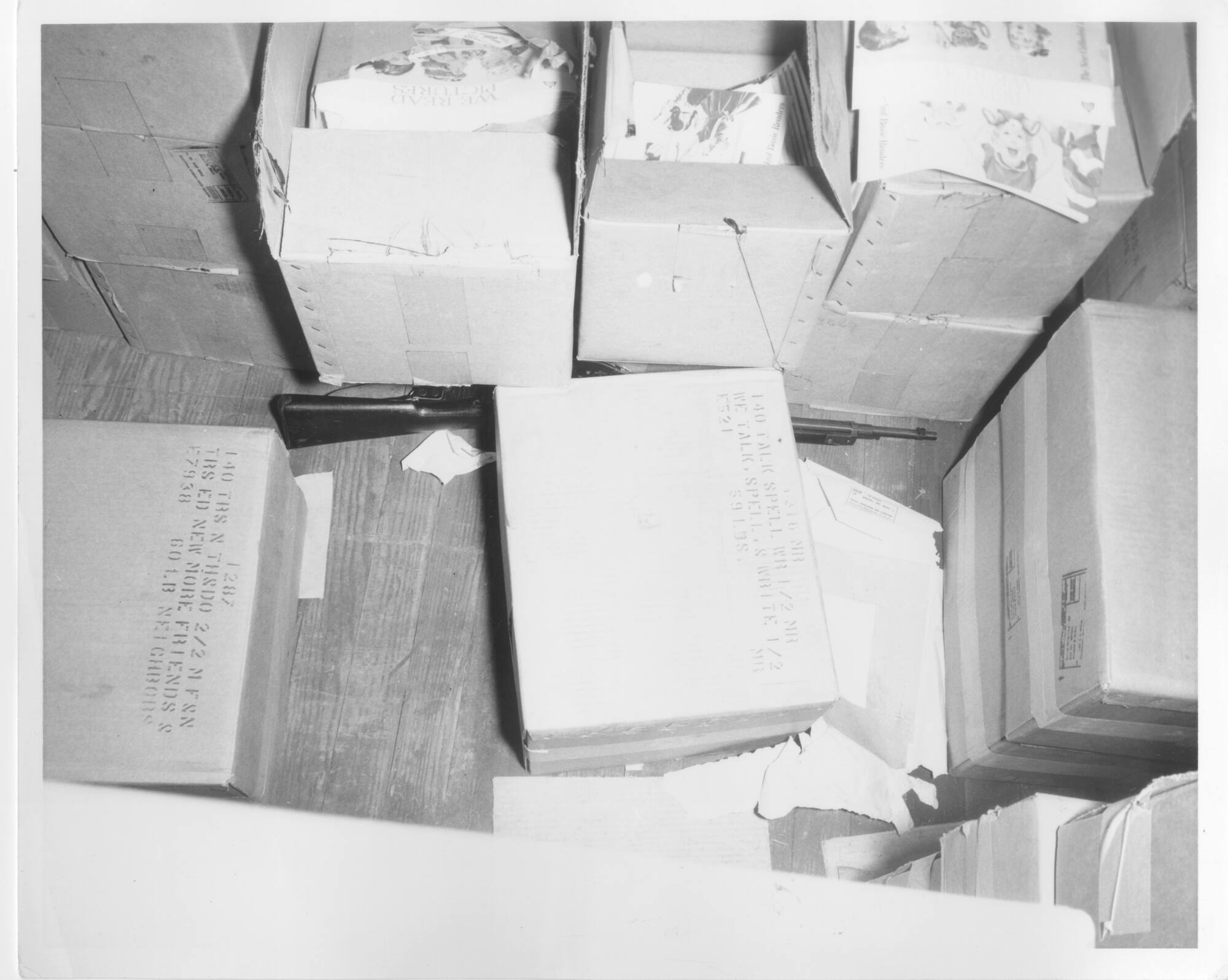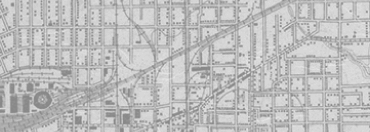


Back
Photograph of rifle hidden between boxes
Black and white photographic print taken by the Dallas Police Crime Scene Search Unit of the Mannlicher-Carcano rifle as it was found on the floor. The location was in the northwest corner on the sixth floor of the Texas School Book Depository.All crime scene photos taken inside the Texas School Book Depository that day were shot either by Detective Robert L. Studebaker or, in a few cases, the head of the Dallas Police Crime Scene Search Unit, Lt. J. C. "Carl" Day. R. W. "Rusty" Livingston, also an employee of the police crime lab, developed many of the images taken by Studebaker and Day. This collection of prints is a first-generation set of copies he kept for himself.
Photograph of rifle hidden between boxes
11/22/1963
Paper
8 x 10 in. (20.3 x 25.4 cm)
Dallas Police Department photograph, R. W. "Rusty" Livingston Collection/The Sixth Floor Museum at Dealey Plaza
2002.002.0051
This picture shows Lee Harvey Oswald's Mannlicher-Carcano rifle where it was found by investigators at 1:22 p.m., about 52 minutes after the assassination. The camera view is looking toward the north. From this view, some misidentified the weapon as a German Mauser and that information quickly went out to the news media. Later, after Dallas Police crime lab investigator Carl Day examined the weapon further he found it was an Italian weapon manufactured in 1940. The next morning, the FBI confirmed it was a surplus rifle known as a 6.5mm Mannlicher-Carcano. By checking microfilm records at Klein Sporting Goods of Chicago, the FBI found Oswald's original order under the name Alex Hidell - a fake name favored by Oswald - asking for the weapon to be shipped to Oswald's personal post office box in Dallas. - Gary Mack, Curator
Dallas County deputy sheriff Eugene Boone recalled in a 2003 oral history how the Mannlicher-Carcano rifle was discovered: "We were looking for any kind of evidence or anything that didn't belong there. And as we approached the west side of the building, the stairwell was in the northwest corner of the building. And I was looking down between two rows of books in a crevice underneath a row of books. And there were like two or three books high--cases of books high--and the top row of books had been pushed over a little bit so as to conceal a crevice that was there from the underneath side. And what it looked like to me was that as somebody ran across the floor, that had been set up--prearranged set up--and it just gave them a frame of reference to quickly shove the rifle in that crevice between the two rows of books. And so, I found the rifle. Said, "Here's the rifle," and tried to protect the scene from any officers. -- Stephen Fagin, Curator

Photograph of rifle hidden between boxes
Black and white photographic print taken by the Dallas Police Crime Scene Search Unit of the Mannlicher-Carcano rifle as it was found on the floor. The location was in the northwest corner on the sixth floor of the Texas School Book Depository.All crime scene photos taken inside the Texas School Book Depository that day were shot either by Detective Robert L. Studebaker or, in a few cases, the head of the Dallas Police Crime Scene Search Unit, Lt. J. C. "Carl" Day. R. W. "Rusty" Livingston, also an employee of the police crime lab, developed many of the images taken by Studebaker and Day. This collection of prints is a first-generation set of copies he kept for himself.
Photograph of rifle hidden between boxes
11/22/1963
Boxes
Mannlicher-Carcano
Photographs
Rifles
Investigations
Assassination
Day, Carl
Livingston, R. W. "Rusty"
Studebaker, Robert L.
Dallas Police Department
Dallas Police Crime Scene Search Unit
Texas School Book Depository
Dallas
Paper
8 x 10 in. (20.3 x 25.4 cm)
Dallas Police Department photograph, R. W. "Rusty" Livingston Collection/The Sixth Floor Museum at Dealey Plaza
2002.002.0051
This picture shows Lee Harvey Oswald's Mannlicher-Carcano rifle where it was found by investigators at 1:22 p.m., about 52 minutes after the assassination. The camera view is looking toward the north. From this view, some misidentified the weapon as a German Mauser and that information quickly went out to the news media. Later, after Dallas Police crime lab investigator Carl Day examined the weapon further he found it was an Italian weapon manufactured in 1940. The next morning, the FBI confirmed it was a surplus rifle known as a 6.5mm Mannlicher-Carcano. By checking microfilm records at Klein Sporting Goods of Chicago, the FBI found Oswald's original order under the name Alex Hidell - a fake name favored by Oswald - asking for the weapon to be shipped to Oswald's personal post office box in Dallas. - Gary Mack, Curator
Dallas County deputy sheriff Eugene Boone recalled in a 2003 oral history how the Mannlicher-Carcano rifle was discovered: "We were looking for any kind of evidence or anything that didn't belong there. And as we approached the west side of the building, the stairwell was in the northwest corner of the building. And I was looking down between two rows of books in a crevice underneath a row of books. And there were like two or three books high--cases of books high--and the top row of books had been pushed over a little bit so as to conceal a crevice that was there from the underneath side. And what it looked like to me was that as somebody ran across the floor, that had been set up--prearranged set up--and it just gave them a frame of reference to quickly shove the rifle in that crevice between the two rows of books. And so, I found the rifle. Said, "Here's the rifle," and tried to protect the scene from any officers. -- Stephen Fagin, Curator









